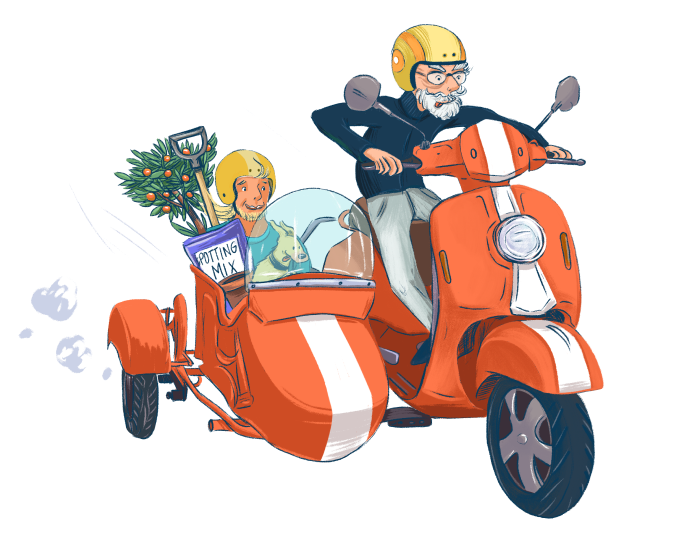Driving - when to step away from the wheel

If you’re concerned about your loved one getting behind the wheel, the best thing to do is start the conversation early. It’s never going to be an easy one to have, but at least you’ll have a plan of attack when it comes time to give up the keys.
For some, the transition to getting off the road is a slow one where you may need to encourage the change, but for others it can be a moment of recognition they have for themselves.
Adjusting to life without a driver’s licence is often challenging and highly emotional. They can feel angry and frustrated, or even ashamed and anxious about how they’ll cope with this loss of mobility.
These feels are exacerbated when the decision to stop is made, or enforced, abruptly with no prior discussion or planning. Your loved one may feel a genuine sense of loss. When this is combined with reduced social connectedness, it can lead to isolation and depression.
The earlier we have conversations and develop a plan, the more positive the experience. Talk to your loved one about what being mobile means to them and do some research about alternative transport options. Think about other ways you can support them to maintain their social interests and hobbies, as well as their connection to their friend and family network and their community.
How long can an older person keep their licence for?
There are no specific rules about how old you can drive for and usually no upper age limit to renewing your licence. Most states and territories will require additional medical or driving tests as your loved one ages. However, there might come a point that it feels safer for your loved one to stop driving.
For some, the transition to getting off the road is slow and you may need to encourage the change. For others, it can be a moment of recognition they have for themselves.
Elsie Frindt, 84, was always careful when parking at her local shopping centre. After hitting a pole trying to park one day, she questioned whether she should still be driving.
“There were no cars and no people and the park was completely empty, but there was a pole about half a metre high and my car decided that it liked it,” Elsie joked. “I started thinking that it might be time to stop driving and by the time my car had been repaired, I decided it was time.”
While it's hard to admit, older drivers are more at risk on the roads. It’s of particular concern if they have vision and hearing impairments, reduced muscle strength and slow reaction times.
Working out when it’s time to hand back the keys
Your first step is to check how they’re coping on the road. Drive with them now and then and see how they’re managing. Are they missing turns, getting confused or not reacting quickly enough?
You might also want to check for close calls. Inspect their car and garage for any scratches or dents, and monitor any traffic infringement notices. These are all signs that could add up to a big risk on the road.
Finally, have a chat with your loved one. Ask how they’re feeling about driving. Here is a checklist of things to consider when talking to your loved one:
Do you have a medical condition or take medication that could impair your driving?
Do you have difficulty reacting quickly to other drivers’ actions?
Do you drive too fast or too slow?
Do you rely on your passengers to help you gauge when it’s clear to pass or turn?
Do you get flustered or angry when driving?
Can you turn your head, neck and shoulders easily when head-checking or parking?
Do bright lights or sunshine affect your vision?
Have you had one or more accidents recently?
Do you feel exhausted after driving for an hour?
Have you been warned by passengers about road hazards you didn’t notice?
Do you feel uncomfortable in heavy traffic?
If they answer ‘yes’ to more than a handful of these questions, you may need to have a conversation about whether it’s time to stop driving.
How to get used to not driving
If it becomes apparent that your loved one is safer off the road, there’s no denying it could be a difficult transition. It’s something that is greatly missed because of the independence it brings. However, with time and support it will get easier. Your loved one will settle into a new routine and find safer ways of getting around.
- Consider your location - Are you or your loved one living somewhere that has easy access to public transport? If not, would it be better for them to be settled somewhere with closer access to a train, bus or tram?
- Would a retirement village be better? - If your loved one is no longer behind the wheel, but also dealing with other ailments or mobility issues, it could be time to consider a retirement village. As well as access to other services within the community, there’ll likely be transport options to help get to and from doctor appointments and other social activities.
- Access community transport services - So often, the responsibility can fall on the child or loved one of someone who has lost their licence to help with transport. As a carer, if you’re not able to do so, consider using the community transport services that are available. See below for more details.
- Keep the social calendar filled - One of the reasons losing a driver’s licence is so difficult is because your loved one might then feel isolated from the outside world. Make sure they’ve got social commitments locked in throughout the week. Whether it’s a regular book club meeting or a lunch date, it means they’ll still have plenty of excuses to get out of the house.
- Get online where possible - With online shopping so readily available, this is one way to make sure your loved one is still getting the basics they need without needing to get in a car.
- Plan ahead - If you’re the primary caregiver or have volunteered to drive them to appointments, try to plan ahead. That way, it’ll feel the least disruptive to everyone.
Community and subsidised transport services
If you or your loved one are looking into other transport options, these organisations can provide ongoing help.
Community organisations - There is a wide range of not-for-profit, charity, religious, cultural and community groups that provide free or low-cost transport help for older people. There are local organisations such as churches, rotary and St John Community Transport Services.
Local councils - Local councils frequently offer transport in two forms:
- Community buses: These buses usually operate on a weekly basis, with many offering the convenience of door-to-door pickup and drop-off. As well as taking residents to shopping centres, many council-run community buses visit other services and activities, such as libraries and seniors’ clubs and groups. There is usually a nominal charge for using the service, which may vary depending on where it is going.
- Personal transport: Some councils offer personal transport for medical, wellbeing and other essential appointments. Once again, there is usually a small charge for the service, and fees may vary depending on the distance you’re travelling and whether you require a return journey.
State and territory governments - Many states have their own initiatives, like New South Wales’ Community Transport Program and the Queensland Government’s Community Transport Scheme. If you choose to use a service like this, you may have to pay a small contribution.
Free or reduced public transport - The Australian Government Pensioner Concession Card will give you access to cheaper public transport rates in all states and territories. Some states and territories even offer pensioners free travel at certain times.
Taxi subsidy schemes - Many state and territory governments operate a taxi subsidy scheme to help with getting to appointments, socialising and shopping trips. How much they contribute to the taxi cost will vary depending on which state or territory you’re living in.
Home care funding - For those eligible for a Home Care Package, you may get transport funding. It can help with accessing shopping centres, visiting health practitioners and attending social activities.
Carer transport funding - If you’re the primary caregiver of your loved one, you may qualify for subsidised travel through the Carer Allowance. Visit Carer Gateway for more information on subsidised travel.
How to say safe behind the wheel
If you’re monitoring a loved one still behind the wheel, we have some tips so they can safely keep driving as long as possible.
Keep fit - For older drivers, it’s really important to stay physically and mentally active to have the reflexes to respond to the changes in traffic conditions.
Ask family and friends for feedback - Family and friends will always be able to tell your loved one honestly if their skills aren’t up to scratch.
Drive when feeling confident - If an older diver feels unsafe at any time, such as during peak hour traffic, in wet weather or at night, then it’s a good idea to avoid driving at those times.
Look for safety features in a new car - Consider features such as night vision enhancement (lights that move with the wheel direction so you can see better, rear cross traffic alerts to let you know about approaching traffic when you can’t see, emergency braking, rear cameras and sensors and stability control.
Add a nominated representative to their car insurance policy – this is so you or another loved one can talk to the insurance company on their behalf if there’s a time when they can’t.
What are some benefits of handing in your keys?
There can be advantages to your loved one deciding to stop driving themselves rather than having the decision made for them.
If they’ve lost confidence on the road, then it’s the safest decision for themselves and other road users. They will also enjoy cost savings and won’t have to worry about paying for registration, insurance, petrol or maintenance costs.
Getting off the road is a change that could take some getting used to. However, planning allows your loved one to prepare for the positives, rather than getting caught up in the negatives.
